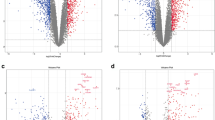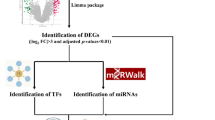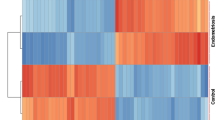Abstract
Endometriosis is a common gynecological disease found in approximately 10% of reproductive-age women. Gene expression analysis has been performed to explore alterations in gene expression associated with endometriosis; however, the underlying transcription factors (TFs) governing such expression changes have not been investigated in a systematic way. In this study, we propose a method to integrate gene expression with TF binding data and protein–protein interactions to construct an integrated regulatory network (IRN) for endometriosis. The IRN has shown that the most regulated gene in endometriosis is RUNX1, which is targeted by 14 of 26 TFs also involved in endometriosis. Using 2 published cohorts, GSE7305 (Hover, n = 20) and GSE7307 (Roth, n = 36) from the Gene Expression Omnibus database, we identified a network of TFs, which bind to target genes that are differentially expressed in endometriosis. Enrichment analysis based on the hypergeometric distribution allowed us to predict the TFs involved in endometriosis (n = 40). This included known TFs such as androgen receptor (AR) and critical factors in the pathology of endometriosis, estrogen receptor α, and estrogen receptor β. We also identified several new ones from which we selected FOXA2 and TFAP2C, and their regulation was confirmed by quantitative real-time polymerase chain reaction and immunohistochemistry (IHC). Further, our analysis revealed that the function of AR and p53 in endometriosis is regulated by posttranscriptional changes and not by differential gene expression. Our integrative analysis provides new insights into the regulatory programs involved in endometriosis.
Similar content being viewed by others
References
Giudice LC. Clinical practice. Endometriosis. N Engl J Med. 2010;362(25):2389–2398.
Rogers PA, D’Hooghe TM, Fazleabas A, et al. Defining future directions for endometriosis research: workshop report from the 2011 World Congress of Endometriosis in Montpellier, France. Reprod Sci. 2013;20(5):483–499.
Bulun SE. Endometriosis. N Engl J Med. 2009;360(3):268–279.
Vinatier D, Orazi G, Cosson M, Dufour P. Theories of endometriosis. Eur J Obstet Gynecol Reprod Biol. 2001;96(1):21–34.
Fauser BC, Diedrich K, Bouchard P, et al. Contemporary genetic technologies and female reproduction. Evian Annual Reproduction. Hum Reprod Update. 2011;17(6):829–847.
Signorile PG, Baldi F, Bussani R, D’Armiento M, De Falco M, Baldi A. Ectopic endometrium in human foetuses is a common event and sustains the theory of mullerianosis in the pathogenesis of endometriosis, a disease that predisposes to cancer. J Exp Clin Canc Res. 2009;28:49.
Matsuura K, Ohtake H, Katabuchi H, Okamura H. Coelomic metaplasia theory of endometriosis: evidence from in vivo studies and an in vitro experimental model. Gynecol Obstet Invest. 1999;47(suppl 1):18–20; discussion 20-12.
Laschke MW, Giebels C, Menger MD. Vasculogenesis: a new piece of the endometriosis puzzle. Hum Reprod Update. 2011;17(5):628–636.
Taylor HS. Endometrial cells derived from donor stem cells in bone marrow transplant recipients. JAMA. 2004;292(1):81–85.
Du H, Taylor HS. Contribution of bone marrow-derived stem cells to endometrium and endometriosis. Stem cells. 2007;25(8):2082–2086.
Sasson IE, Taylor HS. Stem cells and the pathogenesis of endo-metriosis. Ann N Y Acad Sci. 2008;1127:106–115.
Figueira PG, Abrao MS, Krikun G, Taylor HS. Stem cells in endo-metrium and their role in the pathogenesis of endometriosis. Ann N Y Acad Sci. 2011;1221:10–17.
Rogers PA, D’Hooghe TM, Fazleabas A, et al. Priorities for endo-metriosis research: recommendations from an international consensus workshop. Reprod Sci. 2009;16(4):335–346.
Shinohara A, Kutsukake M, Takahashi M, Kyo S, Tachikawa E, Tamura K. Protease-activated receptor-stimulated interleukin-6 expression in endometriosis-like lesions in an experimental mouse model of endometriosis. J Pharmacol Sci. 2012;119(1):40–51.
Khoufache K, Bazin S, Girard K, et al. Macrophage migration inhibitory factor antagonist blocks the development of endome-triosis in vivo. PloS One. 2012;7(5):e37264.
Hever A, Roth RB, Hevezi P, et al. Human endometriosis is associated with plasma cells and overexpression of B lymphocyte stimulator. Proc Natl Acad Sci U S A. 2007;104(30):12451–12456.
Celik O, Celik E, Turkcuoglu I, et al. Surgical removal of endo-metrioma decreases the NF-kB1 (p50/105) and NF-kB p65 (Rel A) expression in the eutopic endometrium during the implantation window. Reprod Sci. 2013;20(7):762–770.
Meola J, Dentillo DB, Rosa e Silva JC, Hidalgo Gdos S, Paz CC, Ferriani RA. RHOC: a key gene for endometriosis. Reprod Sci. 2013;20(8):998–1002.
Governini L, Carrarelli P, Rocha AL, et al. FOXL2 in human endometrium: hyperexpressed in endometriosis. Reprod Sci. 2014;21(10):1249–1255.
Chang JH, Au HK, Lee WC, et al. Expression of the pluripotent transcription factor OCT4 promotes cell migration in endometriosis. Fertil Steril. 2013;99(5):1332–1339. e5.
Xiao W, Awadallah A, Xin W. Loss of ARID1A/BAF250a expression in ovarian endometriosis and clear cell carcinoma. Int J Clin Exp Pathol. 2012;5(7):642–650.
Zhao H, Wang Q, Bai C, He K, Pan Y. A cross-study gene set enrichment analysis identifies critical pathways in endometriosis. Reprod Biol Endocrinol. 2009;7:94.
Gonzalez-Ramos R, Defrere S, Devoto L. Nuclear factor-kappaB: a main regulator of inflammation and cell survival in endometriosis pathophysiology. Fertil Steril. 2012;98(3):520–528.
Yang H, Zhou Y, Edelshain B, Schatz F, Lockwood CJ, Taylor HS. FKBP4 is regulated by HOXA10 during decidualization and in endometriosis. Reproduction. 2012;143(4):531–538.
Fischer CP, Kayisili U, Taylor HS. HOXA10 expression is decreased in endometrium of women with adenomyosis. Fertil Steril. 2011;95(3):1133–1136.
Penna I, Du H, Ferriani R, Taylor HS. Calpain5 expression is decreased in endometriosis and regulated by HOXA10 in human endometrial cells. Mol Hum Reprod. 2008;14(10):613–618.
Kim JJ, Taylor HS, Lu Z, et al. Altered expression of HOXA10 in endometriosis: potential role in decidualization. Mol Hum Reprod. 2007;13(5):323–332.
Browne H, Taylor H. HOXA10 expression in ectopic endometrial tissue. Fertil Steril. 2006;85(5):1386–1390.
Lu H, Yang X, Zhang Y, Lu R, Wang X. Epigenetic disorder may cause downregulation of HOXA10 in the eutopic endometrium of fertile women with endometriosis. Reprod Sci. 2013;20(1):78–84.
Bussemaker HJ, Li H, Siggia ED. Regulatory element detection using correlation with expression. Nat Genet. 2001;27(2):167–171.
Liao JC, Boscolo R, Yang YL, Tran LM, Sabatti C, Roychowdhury VP. Network component analysis: reconstruction of regulatory signals in biological systems. Proc Natl Acad Sci U S A. 2003;100(26):15522–15527.
Alter O, Golub GH. Integrative analysis of genome-scale data by using pseudoinverse projection predicts novel correlation between DNA replication and RNA transcription. Proc Natl Acad Sci U S A. 2004;101(47):16577–16582.
Tsai HK, Lu HH, Li WH. Statistical methods for identifying yeast cell cycle transcription factors. Proc Natl Acad Sci U S A. 20 2005;102(38):13532–13537.
Cheng C, Yan X, Sun F, Li LM. Inferring activity changes of transcription factors by binding association with sorted expression profiles. BMC Bioinformatics. 2007;8:452.
Rhodes DR, Kalyana-Sundaram S, Mahavisno V, Barrette TR, Ghosh D, Chinnaiyan AM. Mining for regulatory programs in the cancer transcriptome. Nat Genet. 2005;37(6):579–583.
Cheng C, Li LM, Alves P, Gerstein M. Systematic identification of transcription factors associated with patient survival in cancers. BMC Genomics. 2009;10:225.
Johnson DS, Mortazavi A, Myers RM, Wold B. Genome-wide mapping of in vivo protein-DNA interactions. Science. 2007;316(5830):1497–1502.
Aparicio O, Geisberg JV, Struhl K. Chromatin immunoprecipitation for determining the association of proteins with specific genomic sequences in vivo. Curr Protoc Cell Biol. 2004;17: Unit 17. 17.
Barrett T, Wilhite SE, Ledoux P, et al. NCBI GEO: archive for functional genomics data sets–update. Nucleic Acids Res. 2013;41(database issue):D991–D995.
Hull ML, Escareno CR, Godsland JM, et al. Endometrial-peritoneal interactions during endometriotic lesion establishment. Am J Pathol. 2008;173(3):700–715.
Lachmann A, Xu H, Krishnan J, Berger SI, Mazloom AR, Ma’ayan A. ChEA: transcription factor regulation inferred from integrating genome-wide ChIP-X experiments. Bioinformatics. 2010;26(19):2438–2444.
Brown KR, Jurisica I. Unequal evolutionary conservation of human protein interactions in interologous networks. Genome Biol. 2007;8(5):R95.
Ravasi T, Suzuki H, Cannistraci CV, et al. An atlas of combinatorial transcriptional regulation in mouse and man. Cell. 2010;140(5):744–752.
Gerstein MB, Lu ZJ, Van Nostrand EL, et al. Integrative analysis of the Caenorhabditis elegans genome by the modENCODE project. Science. 2010;330(6012):1775–1787.
Huang da W, Sherman BT, Lempicki RA. Systematic and integrative analysis of large gene lists using DAVID bioinformatics resources. Nat Protoc. 2009;4(1):44–57.
Applied Biosystems. ABI Prism 7700, User Bulletin. Foster City, CA: 1997.
Barr A, Manning D. G Proteins Techniques of Analysis, Manning DR, ed. Boca Raton, FL: CRC Press, Inc.; 1999:227–245.
Mi H, Dong Q, Muruganujan A, Gaudet P, Lewis S, Thomas PD. PANTHER version 7: improved phylogenetic trees, orthologs and collaboration with the Gene Ontology Consortium. Nucleic Acids Res. 2010;38(Database issue):D204–D210.
Ichikawa M, Asai T, Chiba S, Kurokawa M, Ogawa S. Runx1/ AML-1 ranks as a master regulator of adult hematopoiesis. Cell Cycle. 2004;3(6):722–724.
Konno R, Fujiwara H, Netsu S, et al. Gene expression profiling of the rat endometriosis model. Am J Reprod Immunol. 2007;58(4):330–343.
Wang P, Zhu L, Zhang X. The role of placental protein 14 in the pathogenesis of endometriosis. Reprod Sci. 2013;20(12):1465–1470.
Paech K, Webb P, Kuiper GG, et al. Differential ligand activation of estrogen receptors ERalpha and ERbeta at AP1 sites. Science. 1997;277(5331):1508–1510.
Li X, Huang J, Yi P, Bambara RA, Hilf R, Muyan M. Single-chain estrogen receptors (ERs) reveal that the ERalpha/beta heterodimer emulates functions of the ERalpha dimer in genomic estrogen signaling pathways. Mol Cell Biol. 2004;24(17):7681–7694.
Weihua Z, Saji S, Makinen S, et al. Estrogen receptor (ER) beta, a modulator of ERalpha in the uterus. Proc Natl Acad Sci U S A. 2000;97(11):5936–5941.
Cloke B, Christian M. The role of androgens and the androgen receptor in cycling endometrium. Mol Cell Endocrinol. 2012;358(2):166–175.
Cloke B, Huhtinen K, Fusi L, et al. The androgen and progesterone receptors regulate distinct gene networks and cellular functions in decidualizing endometrium. Endocrinology. 2008;149(9):4462–4474.
Apparao KB, Lovely LP, Gui Y, Lininger RA, Lessey BA. Elevated endometrial androgen receptor expression in women with polycystic ovarian syndrome. Biol Reprod. 2002;66(2):297–304.
Shaik NA, Govindan S, Kodati V, Rao KP, Hasan Q. Polymorphic (CAG)n repeats in the androgen receptor gene: a risk marker for endometriosis and uterine leiomyomas. Hematol Oncol Stem Cell Ther. 2009;2(1):289–293.
Lattuada D, Vigano P, Somigliana E, Odorizzi MP, Vignali M, Di Blasio AM. Androgen receptor gene cytosine, adenine, and gua-nine trinucleotide repeats in patients with endometriosis. J Soc Gynecol Investig. 2004;11(4):237–240.
Hsieh YY, Chang CC, Tsai FJ, Wu JY, Tsai CH, Tsai HD. Androgen receptor trinucleotide polymorphism in endometriosis. Fertil Steril. 2001;76(2):412–413.
Fujimoto J, Hirose R, Sakaguchi H, Tamaya T. Expression of size-polymorphic androgen receptor (AR) gene in ovarian endo-metriosis according to the number of cytosine, adenine, and guanine (CAG) repeats in AR alleles. Steroids. 1999;64(8):526–529.
Carneiro MM, Morsch DM, Camargos AF, Reis FM, Spritzer PM. Androgen receptor and 5alpha-reductase are expressed in pelvic endometriosis. BJOG. 2008;115(1):113–117.
Marshall E, Lowrey J, MacPherson S, et al. In silico analysis identifies a novel role for androgens in the regulation of human endo-metrial apoptosis. J Clin Endocrinol Metab. 2011;96(11):E1746–E1755.
Ammendola M, Gloria-Bottini F, Sesti F, Piccione E, Bottini E. Association of p53 codon 72 polymorphism with endometriosis. Fertil Steril. 2008;90(2):406–408.
Govatati S, Chakravarty B, Deenadayal M, et al. p53 and risk of endometriosis in Indian women. Genet Test Mol Biomarkers. 2012;16(8):865–873.
Jia S, Xu L, Chan Y, et al. p53 codon 72 polymorphism and endo-metriosis: a meta-analysis. Arch Gynecol Obstet. 2012;285(6):1657–1661.
Ribeiro Junior CL, Arruda JT, Silva CT, Moura KK. Analysis of p53 codon 72 gene polymorphism in Brazilian patients with endo-metriosis. Genet Mol Res. 2009;8(2):494–499.
Ying TH, Tseng CJ, Tsai SJ, et al. Association of p53 and CDKN1A genotypes with endometriosis. Anticancer Res. 2011;31(12):4301–4306.
Gylfason JT, Dang D, Petursdottir V, et al. Quantitative DNA perturbations of p53 in endometriosis: analysis of American and Icelandic cases. Fertil Steril. 2005;84(5):1388–1394.
Bayramoglu H, Duzcan E. Atypical epithelial changes and mutant p53 gene expression in ovarian endometriosis. Pathol Oncol Res. 2001;7(1):33–38.
Bunch K, Tinnemore D, Huff S, Hoffer ZS, Burney RO, Stallings JD. Expression patterns of progesterone receptor membrane components 1 and 2 in endometria from women with and without endometriosis. Reprod Sci. 2014;21(2):190–197.
Author information
Authors and Affiliations
Corresponding author
Rights and permissions
About this article
Cite this article
Yang, H., Kang, K., Cheng, C. et al. Integrative Analysis Reveals Regulatory Programs in Endometriosis. Reprod. Sci. 22, 1060–1072 (2015). https://doi.org/10.1177/1933719115592709
Published:
Issue Date:
DOI: https://doi.org/10.1177/1933719115592709




